FIAT SEDICI 2008 2.G Owners Manual
Manufacturer: FIAT, Model Year: 2008, Model line: SEDICI, Model: FIAT SEDICI 2008 2.GPages: 266, PDF Size: 3.25 MB
Page 151 of 266
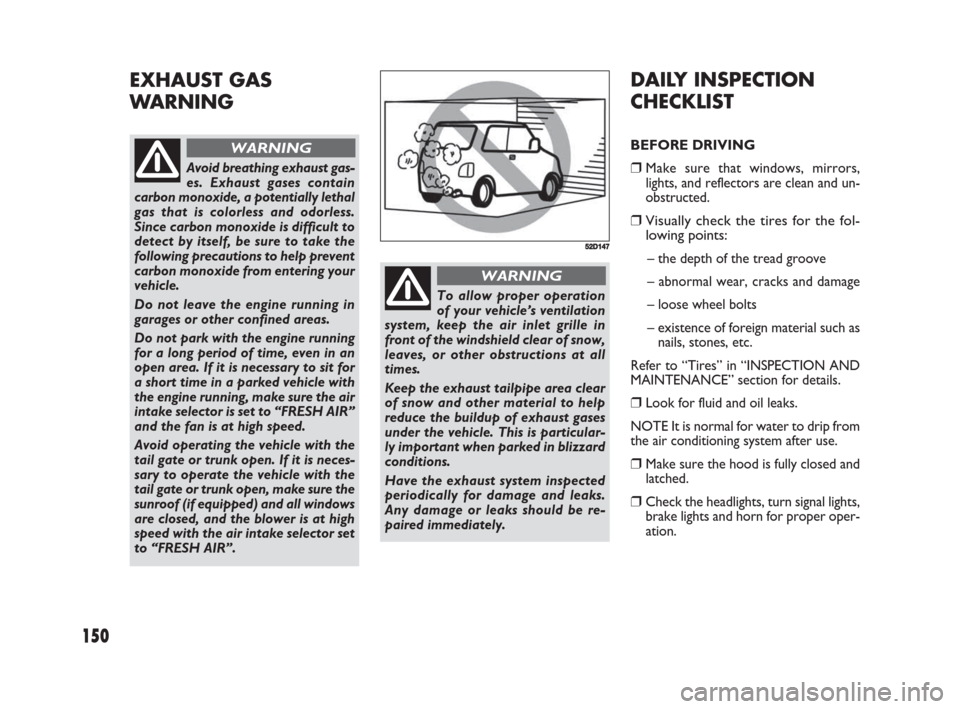
150
DAILY INSPECTION
CHECKLIST
BEFORE DRIVING
❒Make sure that windows, mirrors,
lights, and reflectors are clean and un-
obstructed.
❒Visually check the tires for the fol-
lowing points:
– the depth of the tread groove
– abnormal wear, cracks and damage
– loose wheel bolts
– existence of foreign material such as
nails, stones, etc.
Refer to “Tires” in “INSPECTION AND
MAINTENANCE” section for details.
❒Look for fluid and oil leaks.
NOTE It is normal for water to drip from
the air conditioning system after use.
❒Make sure the hood is fully closed and
latched.
❒Check the headlights, turn signal lights,
brake lights and horn for proper oper-
ation.
EXHAUST GAS
WARNING
52D147
Avoid breathing exhaust gas-
es. Exhaust gases contain
carbon monoxide, a potentially lethal
gas that is colorless and odorless.
Since carbon monoxide is difficult to
detect by itself, be sure to take the
following precautions to help prevent
carbon monoxide from entering your
vehicle.
Do not leave the engine running in
garages or other confined areas.
Do not park with the engine running
for a long period of time, even in an
open area. If it is necessary to sit for
a short time in a parked vehicle with
the engine running, make sure the air
intake selector is set to “FRESH AIR”
and the fan is at high speed.
Avoid operating the vehicle with the
tail gate or trunk open. If it is neces-
sary to operate the vehicle with the
tail gate or trunk open, make sure the
sunroof (if equipped) and all windows
are closed, and the blower is at high
speed with the air intake selector set
to “FRESH AIR”.
WARNING
To allow proper operation
of your vehicle’s ventilation
system, keep the air inlet grille in
front of the windshield clear of snow,
leaves, or other obstructions at all
times.
Keep the exhaust tailpipe area clear
of snow and other material to help
reduce the buildup of exhaust gases
under the vehicle. This is particular-
ly important when parked in blizzard
conditions.
Have the exhaust system inspected
periodically for damage and leaks.
Any damage or leaks should be re-
paired immediately.
WARNING
149-166 Fiat16 New GB 3-09-2008 8:15 Pagina 150
Page 152 of 266
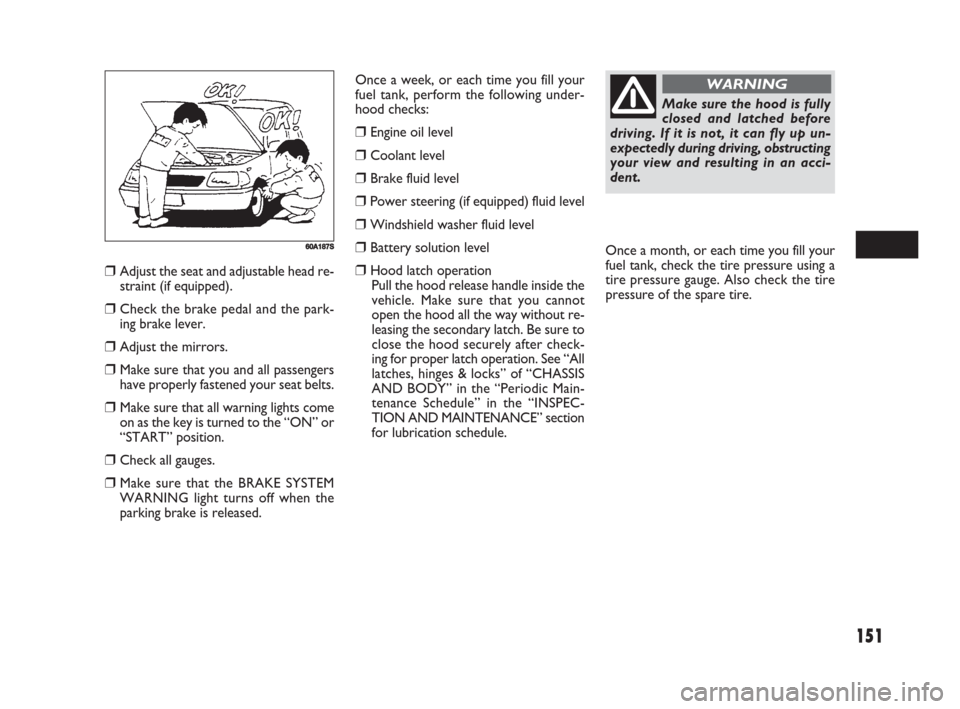
151
Once a week, or each time you fill your
fuel tank, perform the following under-
hood checks:
❒Engine oil level
❒Coolant level
❒Brake fluid level
❒Power steering (if equipped) fluid level
❒Windshield washer fluid level
❒Battery solution level
❒Hood latch operation
Pull the hood release handle inside the
vehicle. Make sure that you cannot
open the hood all the way without re-
leasing the secondary latch. Be sure to
close the hood securely after check-
ing for proper latch operation. See “All
latches, hinges & locks” of “CHASSIS
AND BODY” in the “Periodic Main-
tenance Schedule” in the “INSPEC-
TION AND MAINTENANCE” section
for lubrication schedule.Once a month, or each time you fill your
fuel tank, check the tire pressure using a
tire pressure gauge. Also check the tire
pressure of the spare tire.❒Adjust the seat and adjustable head re-
straint (if equipped).
❒Check the brake pedal and the park-
ing brake lever.
❒Adjust the mirrors.
❒Make sure that you and all passengers
have properly fastened your seat belts.
❒Make sure that all warning lights come
on as the key is turned to the “ON” or
“START” position.
❒Check all gauges.
❒Make sure that the BRAKE SYSTEM
WARNING light turns off when the
parking brake is released.
60A187S
Make sure the hood is fully
closed and latched before
driving. If it is not, it can fly up un-
expectedly during driving, obstructing
your view and resulting in an acci-
dent.
WARNING
149-166 Fiat16 New GB 3-09-2008 8:15 Pagina 151
Page 153 of 266
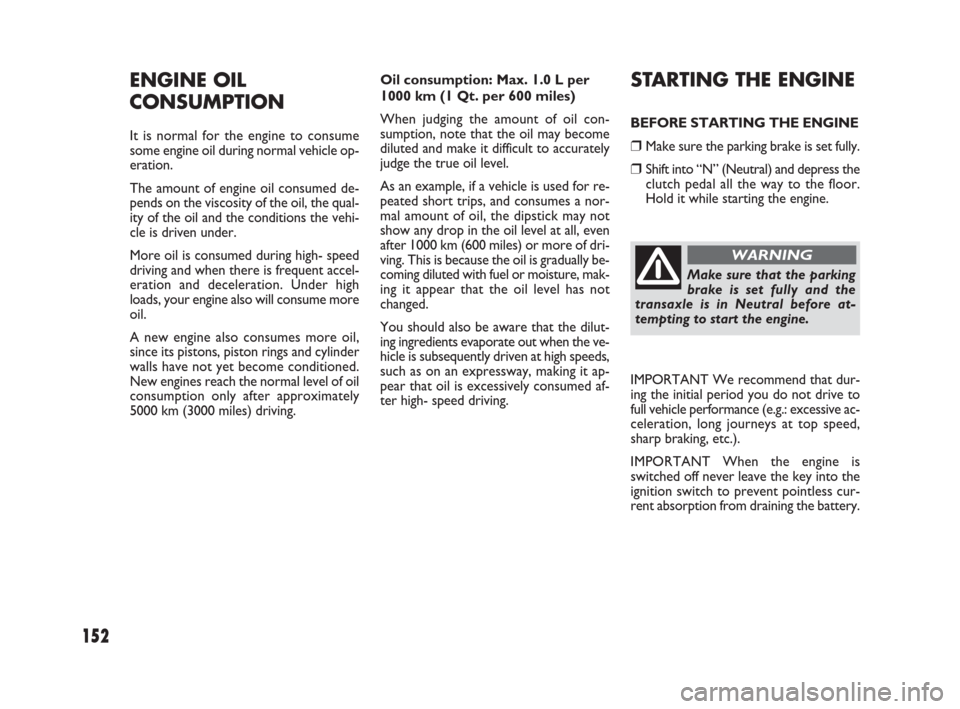
152
Oil consumption: Max. 1.0 L per
1000 km (1 Qt. per 600 miles)
When judging the amount of oil con-
sumption, note that the oil may become
diluted and make it difficult to accurately
judge the true oil level.
As an example, if a vehicle is used for re-
peated short trips, and consumes a nor-
mal amount of oil, the dipstick may not
show any drop in the oil level at all, even
after 1000 km (600 miles) or more of dri-
ving. This is because the oil is gradually be-
coming diluted with fuel or moisture, mak-
ing it appear that the oil level has not
changed.
You should also be aware that the dilut-
ing ingredients evaporate out when the ve-
hicle is subsequently driven at high speeds,
such as on an expressway, making it ap-
pear that oil is excessively consumed af-
ter high- speed driving.STARTING THE ENGINE
BEFORE STARTING THE ENGINE
❒Make sure the parking brake is set fully.
❒Shift into “N” (Neutral) and depress the
clutch pedal all the way to the floor.
Hold it while starting the engine.
ENGINE OIL
CONSUMPTION
It is normal for the engine to consume
some engine oil during normal vehicle op-
eration.
The amount of engine oil consumed de-
pends on the viscosity of the oil, the qual-
ity of the oil and the conditions the vehi-
cle is driven under.
More oil is consumed during high- speed
driving and when there is frequent accel-
eration and deceleration. Under high
loads, your engine also will consume more
oil.
A new engine also consumes more oil,
since its pistons, piston rings and cylinder
walls have not yet become conditioned.
New engines reach the normal level of oil
consumption only after approximately
5000 km (3000 miles) driving.
Make sure that the parking
brake is set fully and the
transaxle is in Neutral before at-
tempting to start the engine.
WARNING
IMPORTANT We recommend that dur-
ing the initial period you do not drive to
full vehicle performance (e.g.: excessive ac-
celeration, long journeys at top speed,
sharp braking, etc.).
IMPORTANT When the engine is
switched off never leave the key into the
ignition switch to prevent pointless cur-
rent absorption from draining the battery.
149-166 Fiat16 New GB 3-09-2008 8:15 Pagina 152
Page 154 of 266
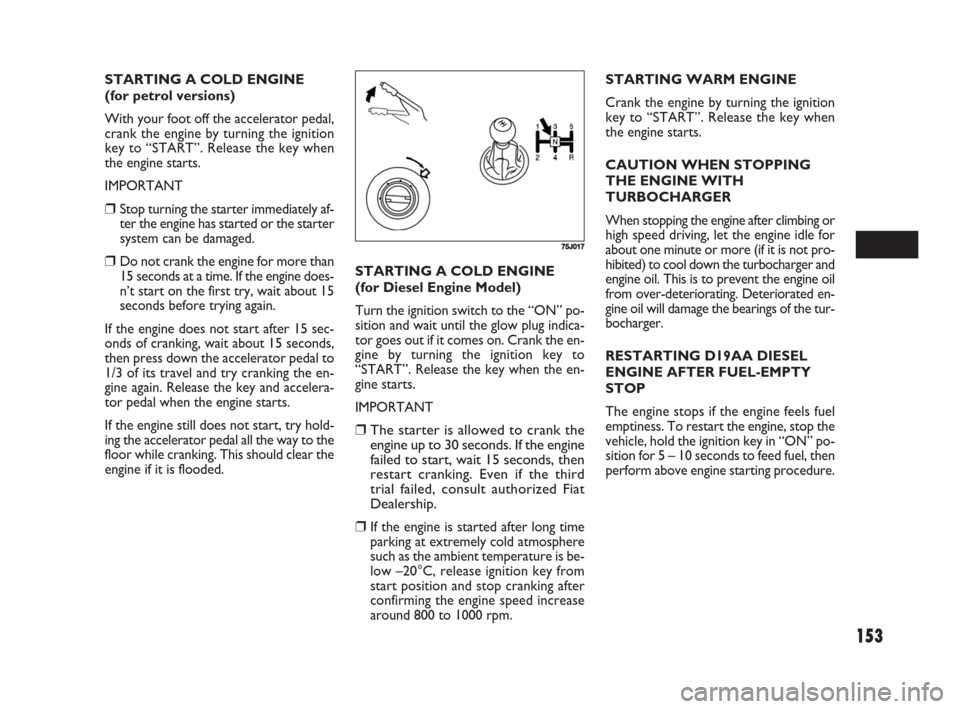
153
STARTING A COLD ENGINE
(for petrol versions)
With your foot off the accelerator pedal,
crank the engine by turning the ignition
key to “START”. Release the key when
the engine starts.
IMPORTANT
❒Stop turning the starter immediately af-
ter the engine has started or the starter
system can be damaged.
❒Do not crank the engine for more than
15 seconds at a time. If the engine does-
n’t start on the first try, wait about 15
seconds before trying again.
If the engine does not start after 15 sec-
onds of cranking, wait about 15 seconds,
then press down the accelerator pedal to
1/3 of its travel and try cranking the en-
gine again. Release the key and accelera-
tor pedal when the engine starts.
If the engine still does not start, try hold-
ing the accelerator pedal all the way to the
floor while cranking. This should clear the
engine if it is flooded.
75J017
STARTING A COLD ENGINE
(for Diesel Engine Model)
Turn the ignition switch to the “ON” po-
sition and wait until the glow plug indica-
tor goes out if it comes on. Crank the en-
gine by turning the ignition key to
“START”. Release the key when the en-
gine starts.
IMPORTANT
❒The starter is allowed to crank the
engine up to 30 seconds. If the engine
failed to start, wait 15 seconds, then
restart cranking. Even if the third
trial failed, consult authorized Fiat
Dealership.
❒
If the engine is started after long time
parking at extremely cold atmosphere
such as the ambient temperature is be-
low –20°C, release ignition key from
start position and stop cranking after
confirming the engine speed increase
around 800 to 1000 rpm.STARTING WARM ENGINE
Crank the engine by turning the ignition
key to “START”. Release the key when
the engine starts.
CAUTION WHEN STOPPING
THE ENGINE WITH
TURBOCHARGER
When stopping the engine after climbing or
high speed driving, let the engine idle for
about one minute or more (if it is not pro-
hibited) to cool down the turbocharger and
engine oil. This is to prevent the engine oil
from over-deteriorating. Deteriorated en-
gine oil will damage the bearings of the tur-
bocharger.
RESTARTING D19AA DIESEL
ENGINE AFTER FUEL-EMPTY
STOP
The engine stops if the engine feels fuel
emptiness. To restart the engine, stop the
vehicle, hold the ignition key in “ON” po-
sition for 5 – 10 seconds to feed fuel, then
perform above engine starting procedure.
149-166 Fiat16 New GB 3-09-2008 8:15 Pagina 153
Page 155 of 266
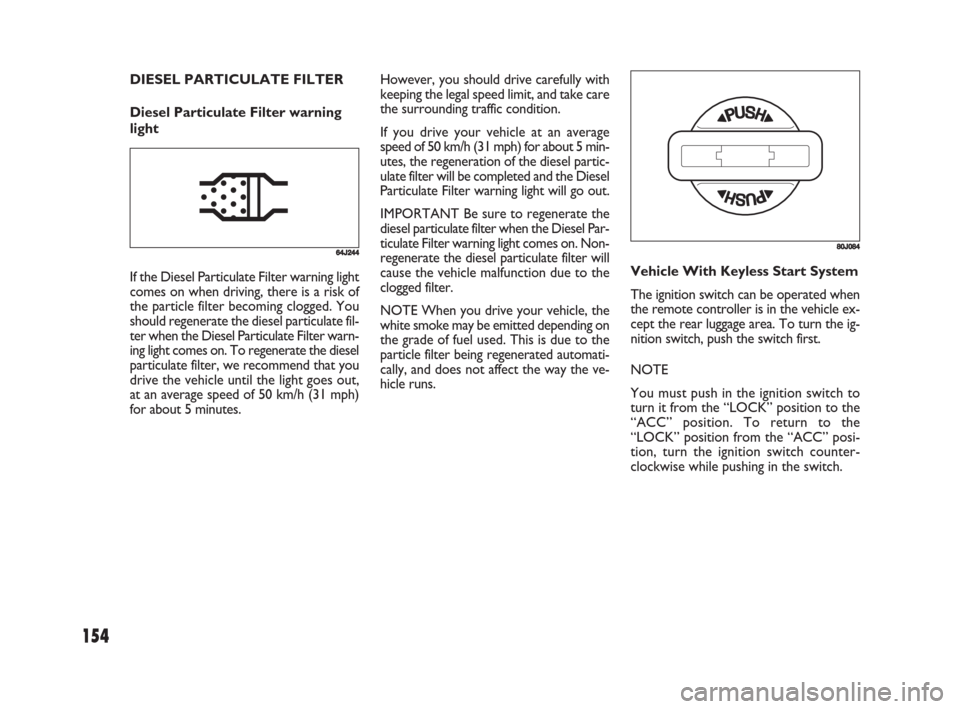
154
DIESEL PARTICULATE FILTER
Diesel Particulate Filter warning
lightHowever, you should drive carefully with
keeping the legal speed limit, and take care
the surrounding traffic condition.
If you drive your vehicle at an average
speed of 50 km/h (31 mph) for about 5 min-
utes, the regeneration of the diesel partic-
ulate filter will be completed and the Diesel
Particulate Filter warning light will go out.
IMPORTANT Be sure to regenerate the
diesel particulate filter when the Diesel Par-
ticulate Filter warning light comes on. Non-
regenerate the diesel particulate filter will
cause the vehicle malfunction due to the
clogged filter.
NOTE When you drive your vehicle, the
white smoke may be emitted depending on
the grade of fuel used. This is due to the
particle filter being regenerated automati-
cally, and does not affect the way the ve-
hicle runs.
64J244
If the Diesel Particulate Filter warning light
comes on when driving, there is a risk of
the particle filter becoming clogged. You
should regenerate the diesel particulate fil-
ter when the Diesel Particulate Filter warn-
ing light comes on. To regenerate the diesel
particulate filter, we recommend that you
drive the vehicle until the light goes out,
at an average speed of 50 km/h (31 mph)
for about 5 minutes.Vehicle With Keyless Start System
The ignition switch can be operated when
the remote controller is in the vehicle ex-
cept the rear luggage area. To turn the ig-
nition switch, push the switch first.
NOTE
You must push in the ignition switch to
turn it from the “LOCK” position to the
“ACC” position. To return to the
“LOCK” position from the “ACC” posi-
tion, turn the ignition switch counter-
clockwise while pushing in the switch.
80J084
149-166 Fiat16 New GB 3-09-2008 8:15 Pagina 154
Page 156 of 266
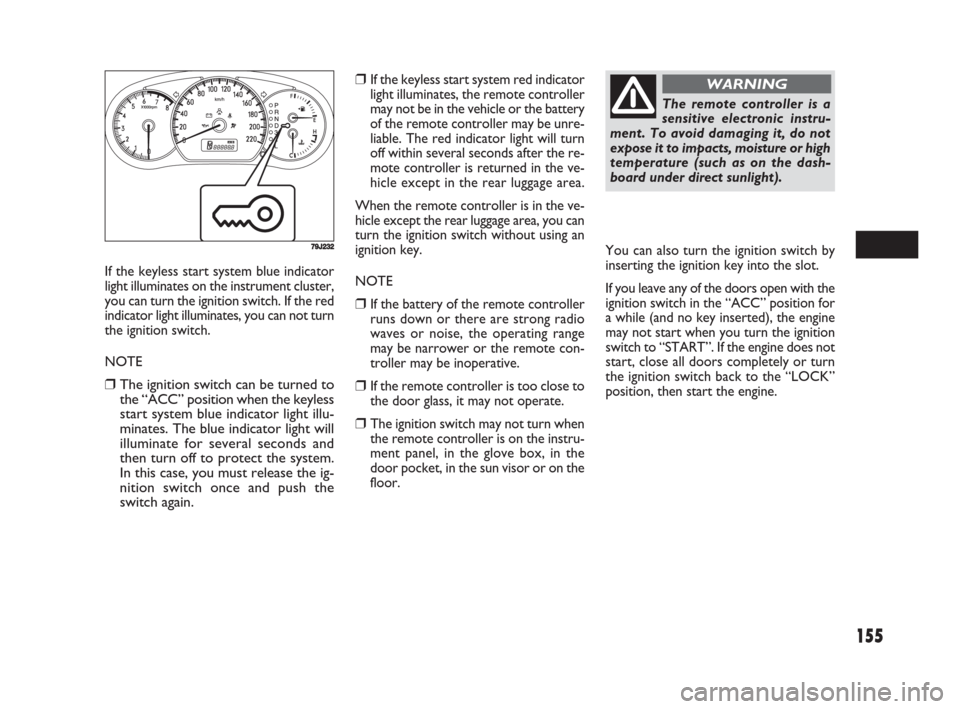
155
If the keyless start system blue indicator
light illuminates on the instrument cluster,
you can turn the ignition switch. If the red
indicator light illuminates, you can not turn
the ignition switch.
NOTE
❒The ignition switch can be turned to
the “ACC” position when the keyless
start system blue indicator light illu-
minates. The blue indicator light will
illuminate for several seconds and
then turn off to protect the system.
In this case, you must release the ig-
nition switch once and push the
switch again.
79J232
❒If the keyless start system red indicator
light illuminates, the remote controller
may not be in the vehicle or the battery
of the remote controller may be unre-
liable. The red indicator light will turn
off within several seconds after the re-
mote controller is returned in the ve-
hicle except in the rear luggage area.
When the remote controller is in the ve-
hicle except the rear luggage area, you can
turn the ignition switch without using an
ignition key.
NOTE
❒If the battery of the remote controller
runs down or there are strong radio
waves or noise, the operating range
may be narrower or the remote con-
troller may be inoperative.
❒If the remote controller is too close to
the door glass, it may not operate.
❒The ignition switch may not turn when
the remote controller is on the instru-
ment panel, in the glove box, in the
door pocket, in the sun visor or on the
floor.
The remote controller is a
sensitive electronic instru-
ment. To avoid damaging it, do not
expose it to impacts, moisture or high
temperature (such as on the dash-
board under direct sunlight).
WARNING
You can also turn the ignition switch by
inserting the ignition key into the slot.
If you leave any of the doors open with the
ignition switch in the “ACC” position for
a while (and no key inserted), the engine
may not start when you turn the ignition
switch to “START”. If the engine does not
start, close all doors completely or turn
the ignition switch back to the “LOCK”
position, then start the engine.
149-166 Fiat16 New GB 3-09-2008 8:15 Pagina 155
Page 157 of 266
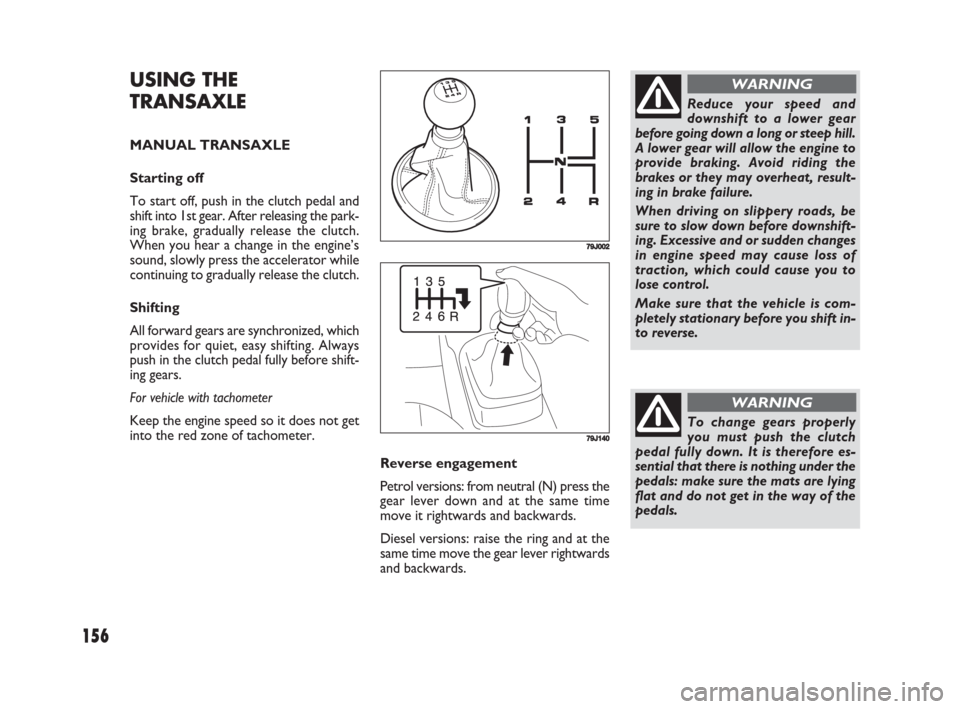
156
779J002
Reduce your speed and
downshift to a lower gear
before going down a long or steep hill.
A lower gear will allow the engine to
provide braking. Avoid riding the
brakes or they may overheat, result-
ing in brake failure.
When driving on slippery roads, be
sure to slow down before downshift-
ing. Excessive and or sudden changes
in engine speed may cause loss of
traction, which could cause you to
lose control.
Make sure that the vehicle is com-
pletely stationary before you shift in-
to reverse.
WARNING
79J140
Reverse engagement
Petrol versions: from neutral (N) press the
gear lever down and at the same time
move it rightwards and backwards.
Diesel versions: raise the ring and at the
same time move the gear lever rightwards
and backwards.
To change gears properly
you must push the clutch
pedal fully down. It is therefore es-
sential that there is nothing under the
pedals: make sure the mats are lying
flat and do not get in the way of the
pedals.
WARNING
USING THE
TRANSAXLE
MANUAL TRANSAXLE
Starting off
To start off, push in the clutch pedal and
shift into 1st gear. After releasing the park-
ing brake, gradually release the clutch.
When you hear a change in the engine’s
sound, slowly press the accelerator while
continuing to gradually release the clutch.
Shifting
All forward gears are synchronized, which
provides for quiet, easy shifting. Always
push in the clutch pedal fully before shift-
ing gears.
For vehicle with tachometer
Keep the engine speed so it does not get
into the red zone of tachometer.
149-166 Fiat16 New GB 3-09-2008 8:15 Pagina 156
Page 158 of 266
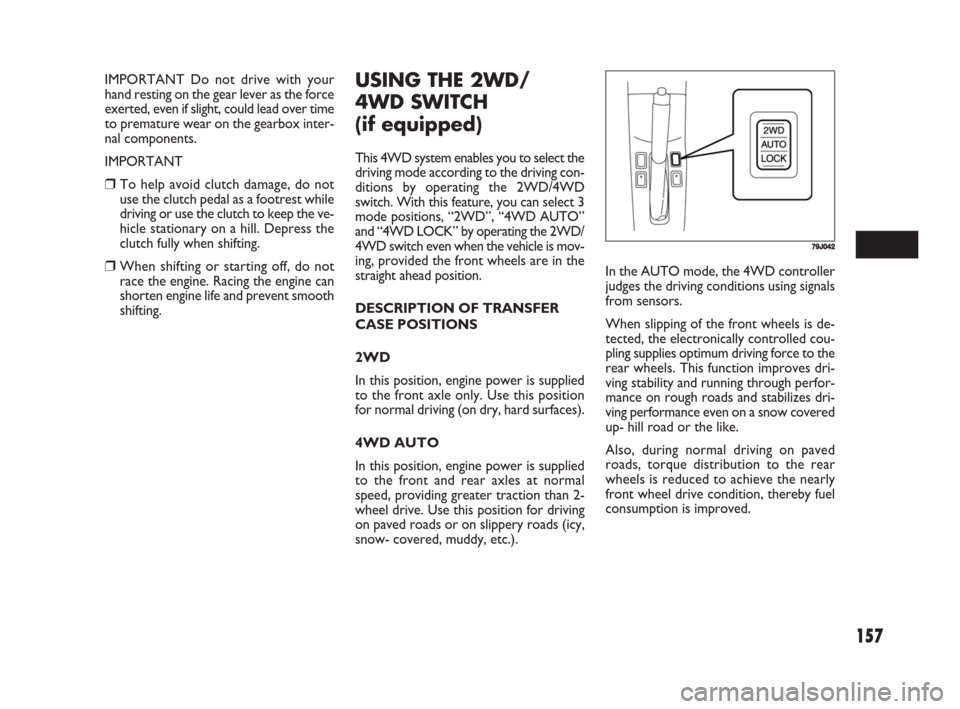
157
IMPORTANT Do not drive with your
hand resting on the gear lever as the force
exerted, even if slight, could lead over time
to premature wear on the gearbox inter-
nal components.
IMPORTANT
❒To help avoid clutch damage, do not
use the clutch pedal as a footrest while
driving or use the clutch to keep the ve-
hicle stationary on a hill. Depress the
clutch fully when shifting.
❒When shifting or starting off, do not
race the engine. Racing the engine can
shorten engine life and prevent smooth
shifting.
USING THE 2WD/
4WD SWITCH
(if equipped)
This 4WD system enables you to select the
driving mode according to the driving con-
ditions by operating the 2WD/4WD
switch. With this feature, you can select 3
mode positions, “2WD”, “4WD AUTO”
and “4WD LOCK” by operating the 2WD/
4WD switch even when the vehicle is mov-
ing, provided the front wheels are in the
straight ahead position.
DESCRIPTION OF TRANSFER
CASE POSITIONS
2WD
In this position, engine power is supplied
to the front axle only. Use this position
for normal driving (on dry, hard surfaces).
4WD AUTO
In this position, engine power is supplied
to the front and rear axles at normal
speed, providing greater traction than 2-
wheel drive. Use this position for driving
on paved roads or on slippery roads (icy,
snow- covered, muddy, etc.).In the AUTO mode, the 4WD controller
judges the driving conditions using signals
from sensors.
When slipping of the front wheels is de-
tected, the electronically controlled cou-
pling supplies optimum driving force to the
rear wheels. This function improves dri-
ving stability and running through perfor-
mance on rough roads and stabilizes dri-
ving performance even on a snow covered
up- hill road or the like.
Also, during normal driving on paved
roads, torque distribution to the rear
wheels is reduced to achieve the nearly
front wheel drive condition, thereby fuel
consumption is improved.
79J042
149-166 Fiat16 New GB 3-09-2008 8:15 Pagina 157
Page 159 of 266
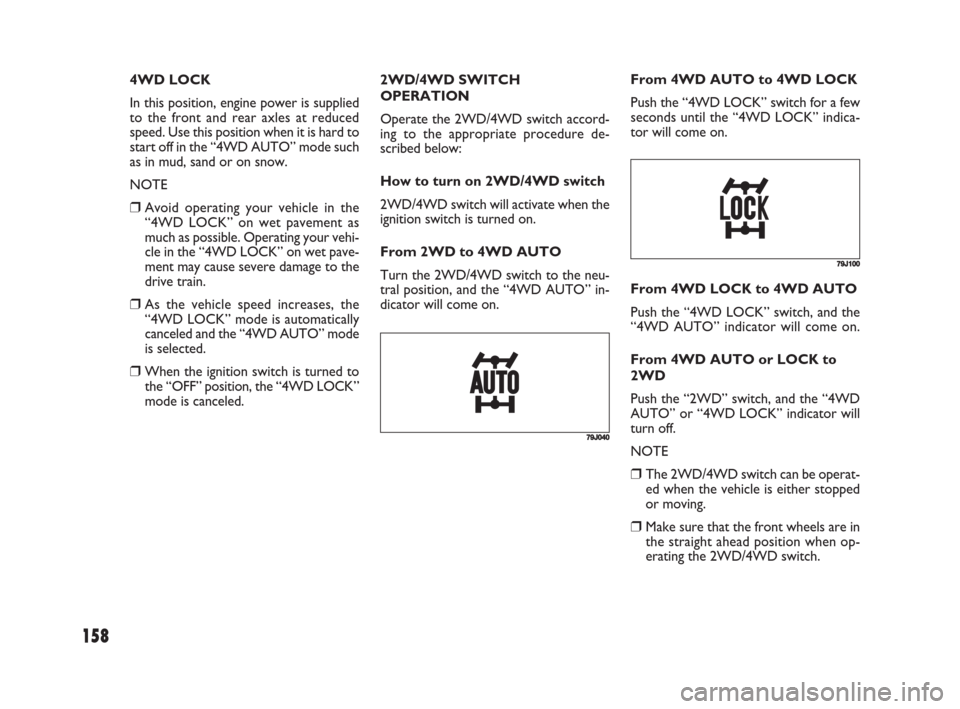
158
2WD/4WD SWITCH
OPERATION
Operate the 2WD/4WD switch accord-
ing to the appropriate procedure de-
scribed below:
How to turn on 2WD/4WD switch
2WD/4WD switch will activate when the
ignition switch is turned on.
From 2WD to 4WD AUTO
Turn the 2WD/4WD switch to the neu-
tral position, and the “4WD AUTO” in-
dicator will come on.From 4WD AUTO to 4WD LOCK
Push the “4WD LOCK” switch for a few
seconds until the “4WD LOCK” indica-
tor will come on. 4WD LOCK
In this position, engine power is supplied
to the front and rear axles at reduced
speed. Use this position when it is hard to
start off in the “4WD AUTO” mode such
as in mud, sand or on snow.
NOTE
❒Avoid operating your vehicle in the
“4WD LOCK” on wet pavement as
much as possible. Operating your vehi-
cle in the “4WD LOCK” on wet pave-
ment may cause severe damage to the
drive train.
❒As the vehicle speed increases, the
“4WD LOCK” mode is automatically
canceled and the “4WD AUTO” mode
is selected.
❒When the ignition switch is turned to
the “OFF” position, the “4WD LOCK”
mode is canceled.
79J040
79J100
From 4WD LOCK to 4WD AUTO
Push the “4WD LOCK” switch, and the
“4WD AUTO” indicator will come on.
From 4WD AUTO or LOCK to
2WD
Push the “2WD” switch, and the “4WD
AUTO” or “4WD LOCK” indicator will
turn off.
NOTE
❒The 2WD/4WD switch can be operat-
ed when the vehicle is either stopped
or moving.
❒Make sure that the front wheels are in
the straight ahead position when op-
erating the 2WD/4WD switch.
149-166 Fiat16 New GB 3-09-2008 8:15 Pagina 158
Page 160 of 266
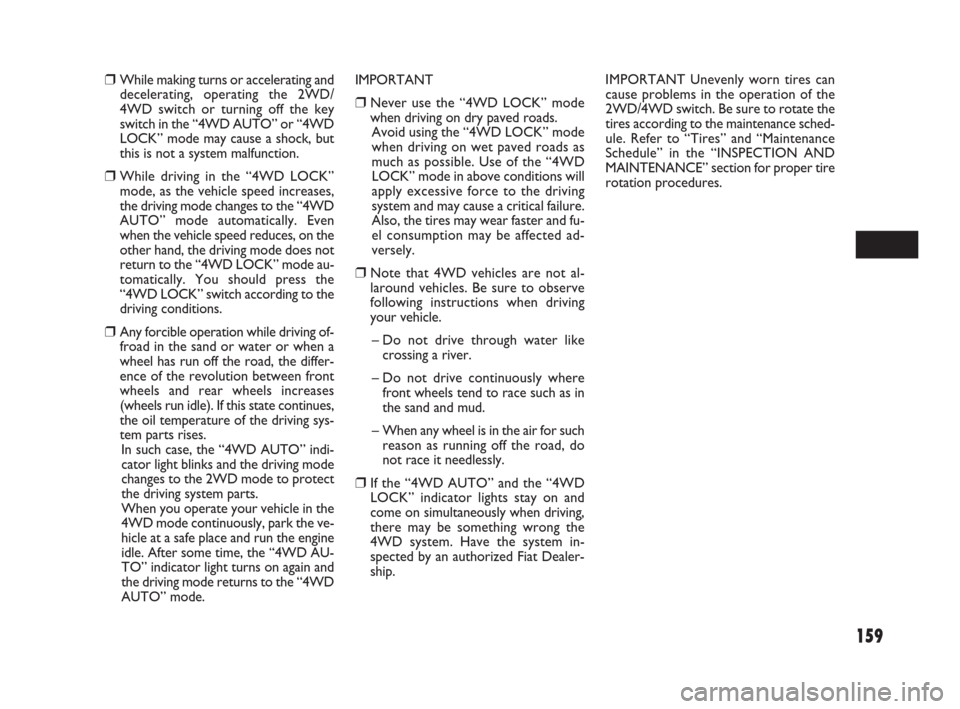
159
IMPORTANT
❒Never use the “4WD LOCK” mode
when driving on dry paved roads.
Avoid using the “4WD LOCK” mode
when driving on wet paved roads as
much as possible. Use of the “4WD
LOCK” mode in above conditions will
apply excessive force to the driving
system and may cause a critical failure.
Also, the tires may wear faster and fu-
el consumption may be affected ad-
versely.
❒Note that 4WD vehicles are not al-
laround vehicles. Be sure to observe
following instructions when driving
your vehicle.
– Do not drive through water like
crossing a river.
– Do not drive continuously where
front wheels tend to race such as in
the sand and mud.
– When any wheel is in the air for such
reason as running off the road, do
not race it needlessly.
❒If the “4WD AUTO” and the “4WD
LOCK” indicator lights stay on and
come on simultaneously when driving,
there may be something wrong the
4WD system. Have the system in-
spected by an authorized Fiat Dealer-
ship.IMPORTANT Unevenly worn tires can
cause problems in the operation of the
2WD/4WD switch. Be sure to rotate the
tires according to the maintenance sched-
ule. Refer to “Tires” and “Maintenance
Schedule” in the “INSPECTION AND
MAINTENANCE” section for proper tire
rotation procedures.
❒While making turns or accelerating and
decelerating, operating the 2WD/
4WD switch or turning off the key
switch in the “4WD AUTO” or “4WD
LOCK” mode may cause a shock, but
this is not a system malfunction.
❒While driving in the “4WD LOCK”
mode, as the vehicle speed increases,
the driving mode changes to the “4WD
AUTO” mode automatically. Even
when the vehicle speed reduces, on the
other hand, the driving mode does not
return to the “4WD LOCK” mode au-
tomatically. You should press the
“4WD LOCK” switch according to the
driving conditions.
❒Any forcible operation while driving of-
froad in the sand or water or when a
wheel has run off the road, the differ-
ence of the revolution between front
wheels and rear wheels increases
(wheels run idle). If this state continues,
the oil temperature of the driving sys-
tem parts rises.
In such case, the “4WD AUTO” indi-
cator light blinks and the driving mode
changes to the 2WD mode to protect
the driving system parts.
When you operate your vehicle in the
4WD mode continuously, park the ve-
hicle at a safe place and run the engine
idle. After some time, the “4WD AU-
TO” indicator light turns on again and
the driving mode returns to the “4WD
AUTO” mode.
149-166 Fiat16 New GB 3-09-2008 8:15 Pagina 159